Economics Report: Monopoly and Monopolistic Competition in Australia
VerifiedAdded on 2023/06/07
|11
|3186
|150
Report
AI Summary
This report provides an analysis of monopoly and monopolistic competition within the Australian economy. It begins by defining the characteristics of monopoly markets, highlighting the market power enjoyed by single sellers, using the Sydney Airport and Australian postal service as examples. The report discusses the need for government intervention through price capping, merger policies, and rate of return regulations to protect consumer interests and ensure efficient resource utilization. It then transitions to monopolistic competition, noting its blend of monopoly and perfect competition features, with examples from the Australian restaurant and coffee industries. The report concludes that government intervention is less necessary in monopolistically competitive markets due to inherent competition and self-regulation. Ultimately, the report provides a comparative overview of these market structures and their implications for the Australian economy.
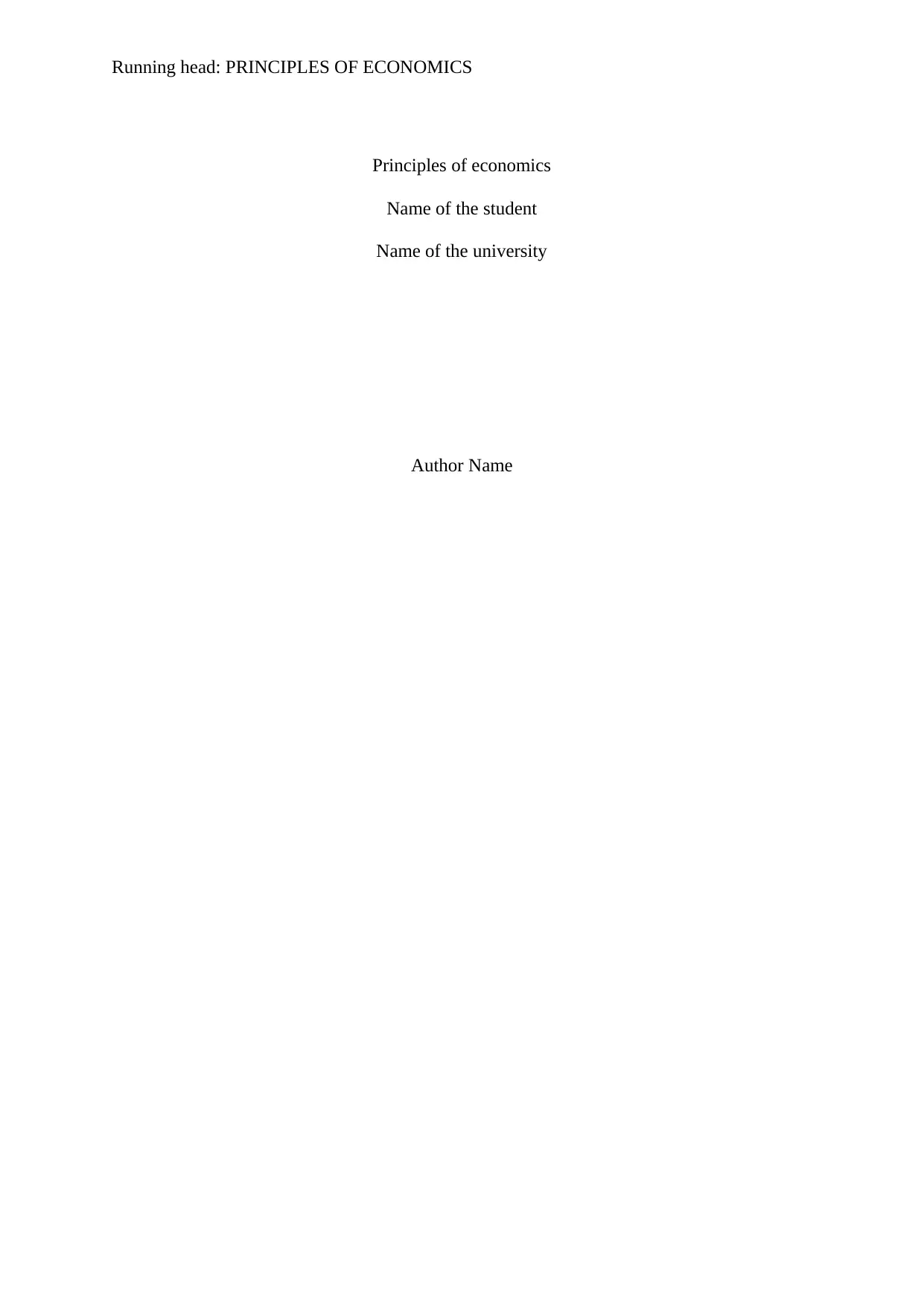
Running head: PRINCIPLES OF ECONOMICS
Principles of economics
Name of the student
Name of the university
Author Name
Principles of economics
Name of the student
Name of the university
Author Name
Paraphrase This Document
Need a fresh take? Get an instant paraphrase of this document with our AI Paraphraser
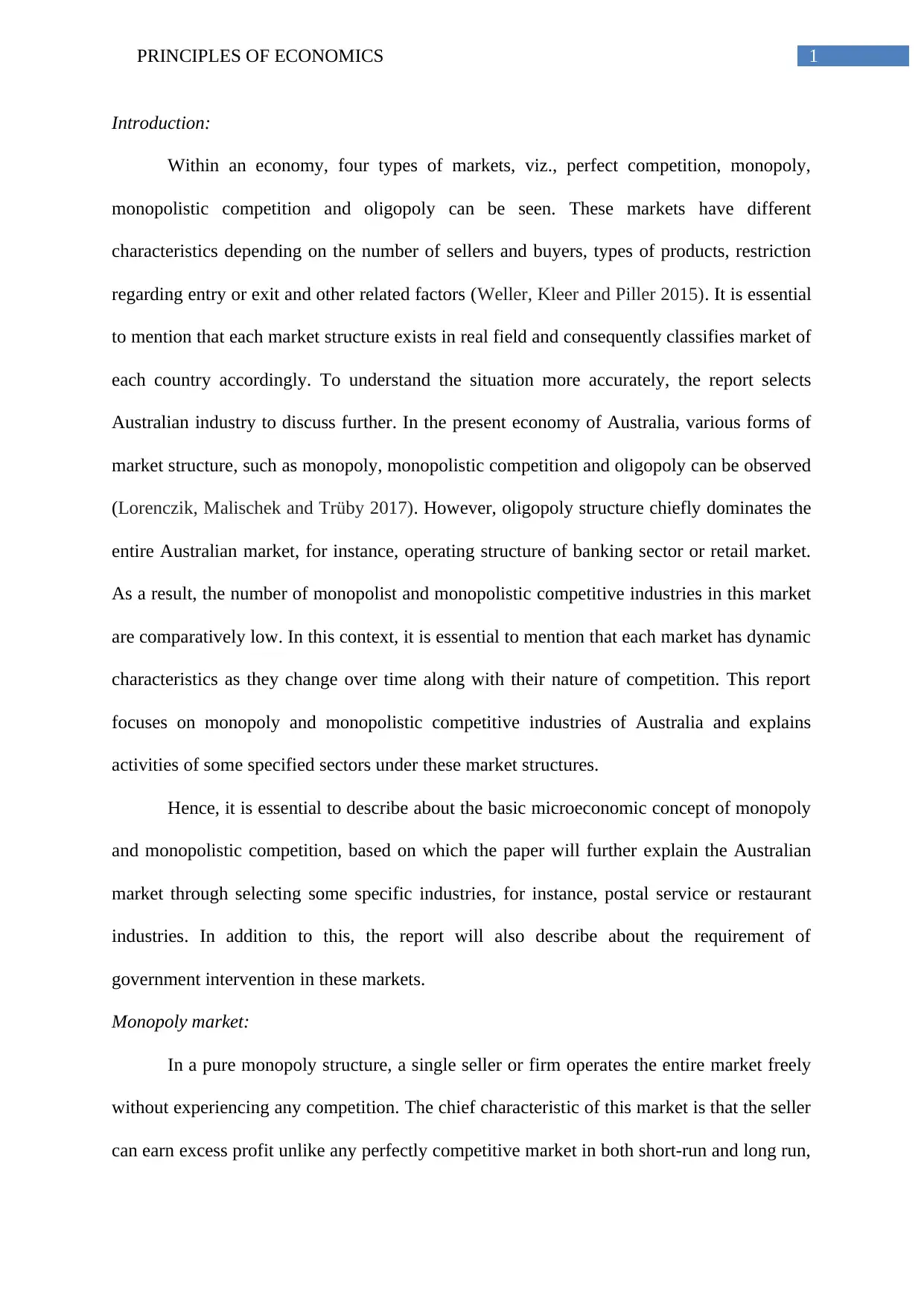
1PRINCIPLES OF ECONOMICS
Introduction:
Within an economy, four types of markets, viz., perfect competition, monopoly,
monopolistic competition and oligopoly can be seen. These markets have different
characteristics depending on the number of sellers and buyers, types of products, restriction
regarding entry or exit and other related factors (Weller, Kleer and Piller 2015). It is essential
to mention that each market structure exists in real field and consequently classifies market of
each country accordingly. To understand the situation more accurately, the report selects
Australian industry to discuss further. In the present economy of Australia, various forms of
market structure, such as monopoly, monopolistic competition and oligopoly can be observed
(Lorenczik, Malischek and Trüby 2017). However, oligopoly structure chiefly dominates the
entire Australian market, for instance, operating structure of banking sector or retail market.
As a result, the number of monopolist and monopolistic competitive industries in this market
are comparatively low. In this context, it is essential to mention that each market has dynamic
characteristics as they change over time along with their nature of competition. This report
focuses on monopoly and monopolistic competitive industries of Australia and explains
activities of some specified sectors under these market structures.
Hence, it is essential to describe about the basic microeconomic concept of monopoly
and monopolistic competition, based on which the paper will further explain the Australian
market through selecting some specific industries, for instance, postal service or restaurant
industries. In addition to this, the report will also describe about the requirement of
government intervention in these markets.
Monopoly market:
In a pure monopoly structure, a single seller or firm operates the entire market freely
without experiencing any competition. The chief characteristic of this market is that the seller
can earn excess profit unlike any perfectly competitive market in both short-run and long run,
Introduction:
Within an economy, four types of markets, viz., perfect competition, monopoly,
monopolistic competition and oligopoly can be seen. These markets have different
characteristics depending on the number of sellers and buyers, types of products, restriction
regarding entry or exit and other related factors (Weller, Kleer and Piller 2015). It is essential
to mention that each market structure exists in real field and consequently classifies market of
each country accordingly. To understand the situation more accurately, the report selects
Australian industry to discuss further. In the present economy of Australia, various forms of
market structure, such as monopoly, monopolistic competition and oligopoly can be observed
(Lorenczik, Malischek and Trüby 2017). However, oligopoly structure chiefly dominates the
entire Australian market, for instance, operating structure of banking sector or retail market.
As a result, the number of monopolist and monopolistic competitive industries in this market
are comparatively low. In this context, it is essential to mention that each market has dynamic
characteristics as they change over time along with their nature of competition. This report
focuses on monopoly and monopolistic competitive industries of Australia and explains
activities of some specified sectors under these market structures.
Hence, it is essential to describe about the basic microeconomic concept of monopoly
and monopolistic competition, based on which the paper will further explain the Australian
market through selecting some specific industries, for instance, postal service or restaurant
industries. In addition to this, the report will also describe about the requirement of
government intervention in these markets.
Monopoly market:
In a pure monopoly structure, a single seller or firm operates the entire market freely
without experiencing any competition. The chief characteristic of this market is that the seller
can earn excess profit unlike any perfectly competitive market in both short-run and long run,
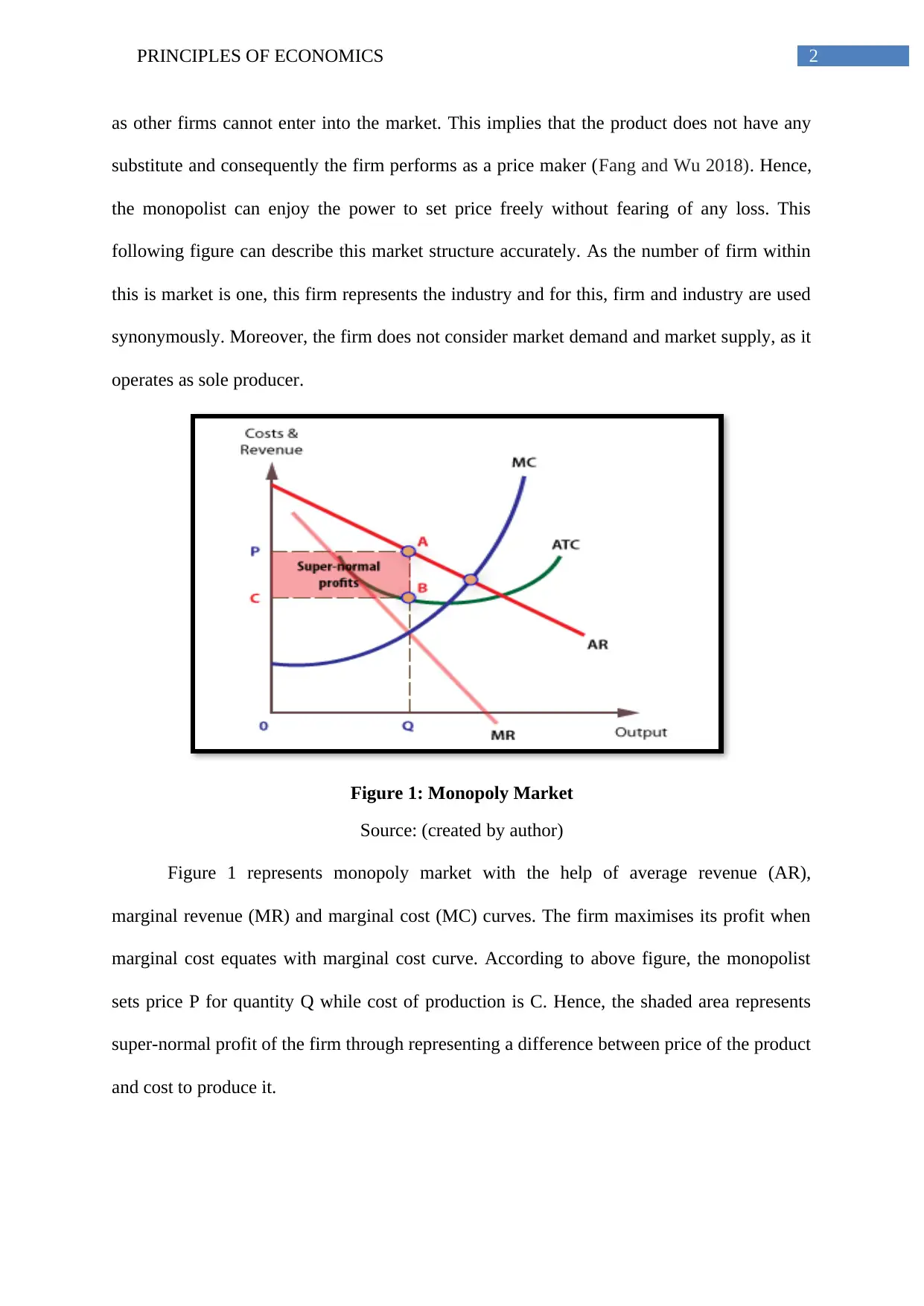
2PRINCIPLES OF ECONOMICS
as other firms cannot enter into the market. This implies that the product does not have any
substitute and consequently the firm performs as a price maker (Fang and Wu 2018). Hence,
the monopolist can enjoy the power to set price freely without fearing of any loss. This
following figure can describe this market structure accurately. As the number of firm within
this is market is one, this firm represents the industry and for this, firm and industry are used
synonymously. Moreover, the firm does not consider market demand and market supply, as it
operates as sole producer.
Figure 1: Monopoly Market
Source: (created by author)
Figure 1 represents monopoly market with the help of average revenue (AR),
marginal revenue (MR) and marginal cost (MC) curves. The firm maximises its profit when
marginal cost equates with marginal cost curve. According to above figure, the monopolist
sets price P for quantity Q while cost of production is C. Hence, the shaded area represents
super-normal profit of the firm through representing a difference between price of the product
and cost to produce it.
as other firms cannot enter into the market. This implies that the product does not have any
substitute and consequently the firm performs as a price maker (Fang and Wu 2018). Hence,
the monopolist can enjoy the power to set price freely without fearing of any loss. This
following figure can describe this market structure accurately. As the number of firm within
this is market is one, this firm represents the industry and for this, firm and industry are used
synonymously. Moreover, the firm does not consider market demand and market supply, as it
operates as sole producer.
Figure 1: Monopoly Market
Source: (created by author)
Figure 1 represents monopoly market with the help of average revenue (AR),
marginal revenue (MR) and marginal cost (MC) curves. The firm maximises its profit when
marginal cost equates with marginal cost curve. According to above figure, the monopolist
sets price P for quantity Q while cost of production is C. Hence, the shaded area represents
super-normal profit of the firm through representing a difference between price of the product
and cost to produce it.
⊘ This is a preview!⊘
Do you want full access?
Subscribe today to unlock all pages.

Trusted by 1+ million students worldwide
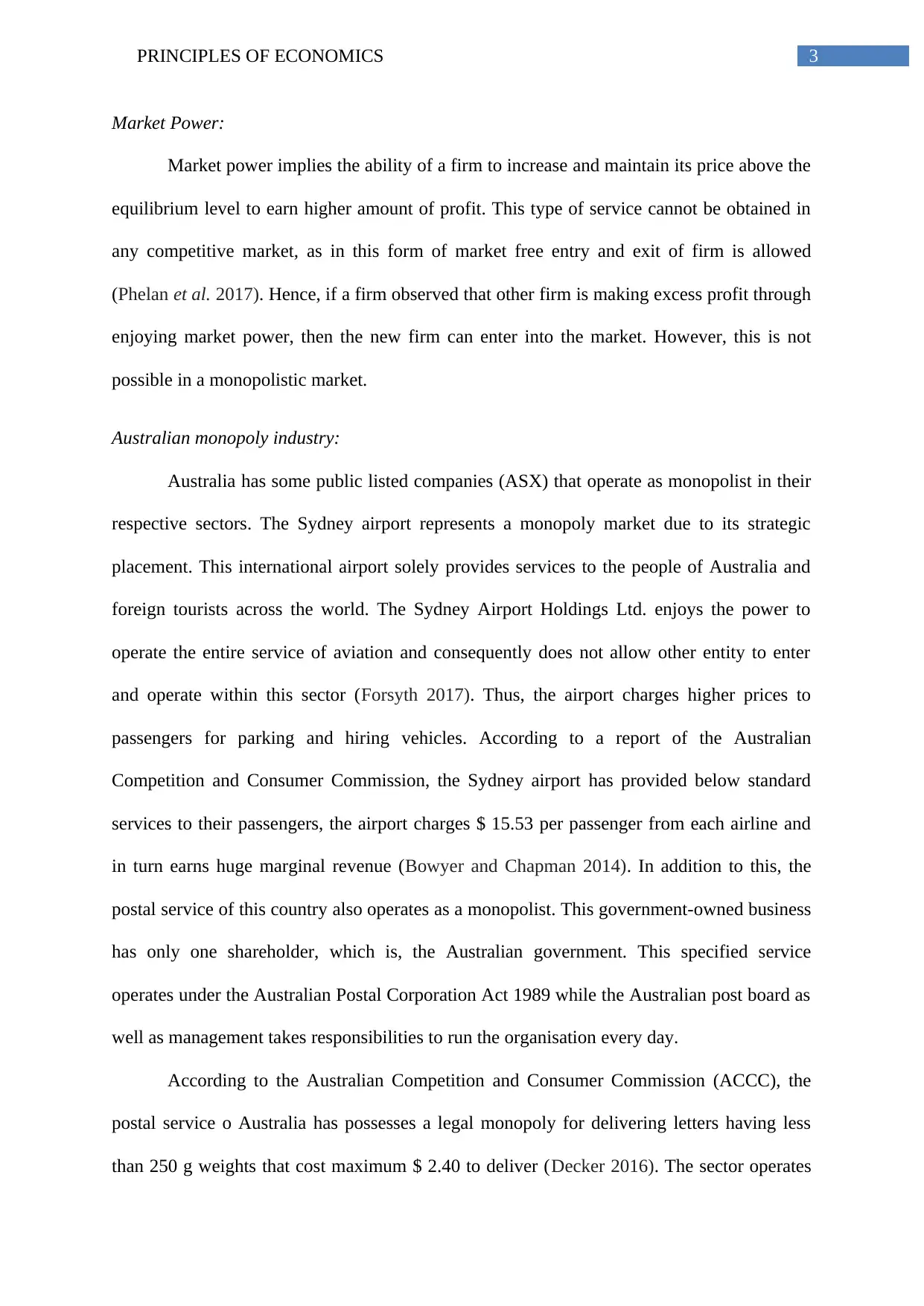
3PRINCIPLES OF ECONOMICS
Market Power:
Market power implies the ability of a firm to increase and maintain its price above the
equilibrium level to earn higher amount of profit. This type of service cannot be obtained in
any competitive market, as in this form of market free entry and exit of firm is allowed
(Phelan et al. 2017). Hence, if a firm observed that other firm is making excess profit through
enjoying market power, then the new firm can enter into the market. However, this is not
possible in a monopolistic market.
Australian monopoly industry:
Australia has some public listed companies (ASX) that operate as monopolist in their
respective sectors. The Sydney airport represents a monopoly market due to its strategic
placement. This international airport solely provides services to the people of Australia and
foreign tourists across the world. The Sydney Airport Holdings Ltd. enjoys the power to
operate the entire service of aviation and consequently does not allow other entity to enter
and operate within this sector (Forsyth 2017). Thus, the airport charges higher prices to
passengers for parking and hiring vehicles. According to a report of the Australian
Competition and Consumer Commission, the Sydney airport has provided below standard
services to their passengers, the airport charges $ 15.53 per passenger from each airline and
in turn earns huge marginal revenue (Bowyer and Chapman 2014). In addition to this, the
postal service of this country also operates as a monopolist. This government-owned business
has only one shareholder, which is, the Australian government. This specified service
operates under the Australian Postal Corporation Act 1989 while the Australian post board as
well as management takes responsibilities to run the organisation every day.
According to the Australian Competition and Consumer Commission (ACCC), the
postal service o Australia has possesses a legal monopoly for delivering letters having less
than 250 g weights that cost maximum $ 2.40 to deliver (Decker 2016). The sector operates
Market Power:
Market power implies the ability of a firm to increase and maintain its price above the
equilibrium level to earn higher amount of profit. This type of service cannot be obtained in
any competitive market, as in this form of market free entry and exit of firm is allowed
(Phelan et al. 2017). Hence, if a firm observed that other firm is making excess profit through
enjoying market power, then the new firm can enter into the market. However, this is not
possible in a monopolistic market.
Australian monopoly industry:
Australia has some public listed companies (ASX) that operate as monopolist in their
respective sectors. The Sydney airport represents a monopoly market due to its strategic
placement. This international airport solely provides services to the people of Australia and
foreign tourists across the world. The Sydney Airport Holdings Ltd. enjoys the power to
operate the entire service of aviation and consequently does not allow other entity to enter
and operate within this sector (Forsyth 2017). Thus, the airport charges higher prices to
passengers for parking and hiring vehicles. According to a report of the Australian
Competition and Consumer Commission, the Sydney airport has provided below standard
services to their passengers, the airport charges $ 15.53 per passenger from each airline and
in turn earns huge marginal revenue (Bowyer and Chapman 2014). In addition to this, the
postal service of this country also operates as a monopolist. This government-owned business
has only one shareholder, which is, the Australian government. This specified service
operates under the Australian Postal Corporation Act 1989 while the Australian post board as
well as management takes responsibilities to run the organisation every day.
According to the Australian Competition and Consumer Commission (ACCC), the
postal service o Australia has possesses a legal monopoly for delivering letters having less
than 250 g weights that cost maximum $ 2.40 to deliver (Decker 2016). The sector operates
Paraphrase This Document
Need a fresh take? Get an instant paraphrase of this document with our AI Paraphraser
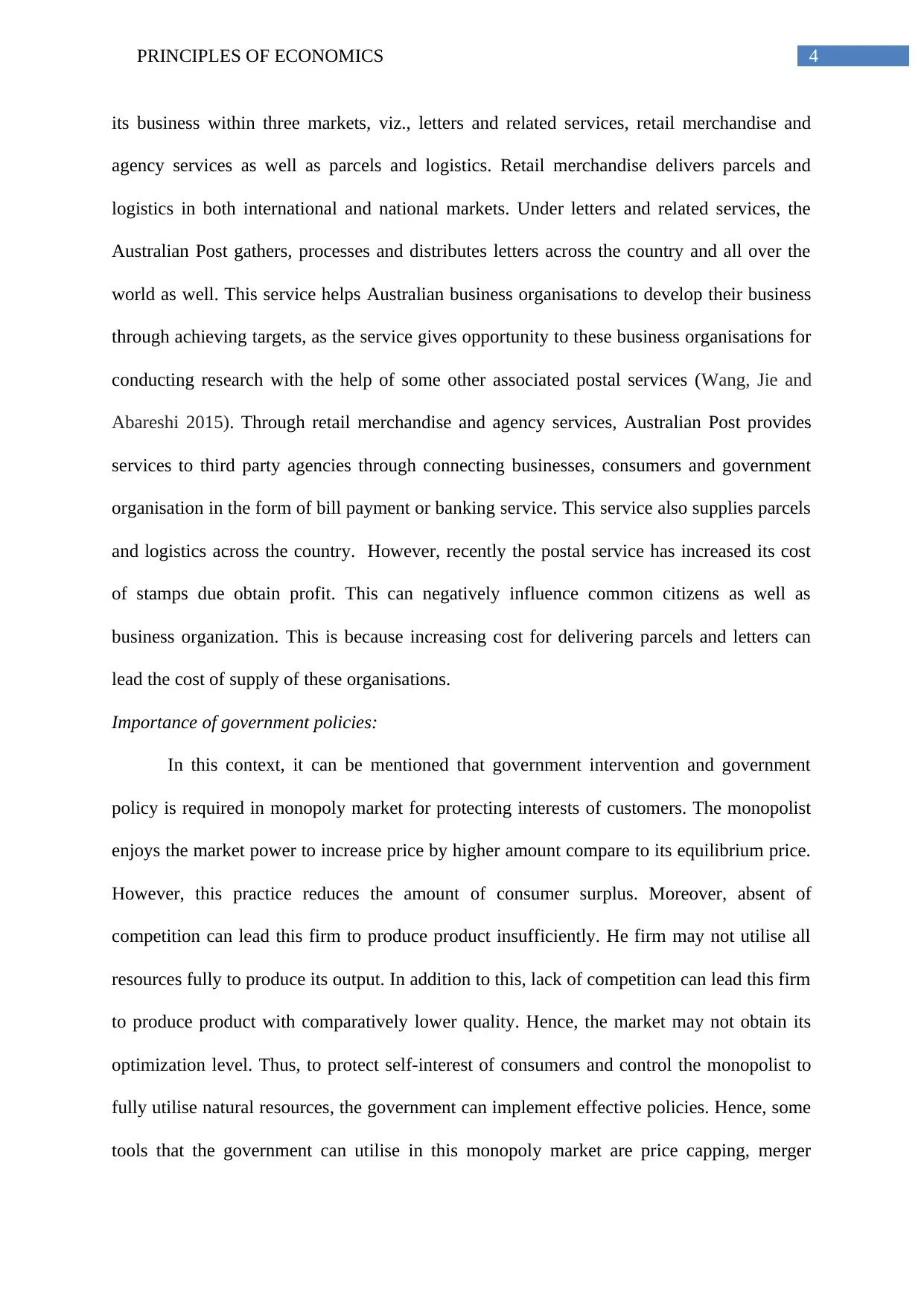
4PRINCIPLES OF ECONOMICS
its business within three markets, viz., letters and related services, retail merchandise and
agency services as well as parcels and logistics. Retail merchandise delivers parcels and
logistics in both international and national markets. Under letters and related services, the
Australian Post gathers, processes and distributes letters across the country and all over the
world as well. This service helps Australian business organisations to develop their business
through achieving targets, as the service gives opportunity to these business organisations for
conducting research with the help of some other associated postal services (Wang, Jie and
Abareshi 2015). Through retail merchandise and agency services, Australian Post provides
services to third party agencies through connecting businesses, consumers and government
organisation in the form of bill payment or banking service. This service also supplies parcels
and logistics across the country. However, recently the postal service has increased its cost
of stamps due obtain profit. This can negatively influence common citizens as well as
business organization. This is because increasing cost for delivering parcels and letters can
lead the cost of supply of these organisations.
Importance of government policies:
In this context, it can be mentioned that government intervention and government
policy is required in monopoly market for protecting interests of customers. The monopolist
enjoys the market power to increase price by higher amount compare to its equilibrium price.
However, this practice reduces the amount of consumer surplus. Moreover, absent of
competition can lead this firm to produce product insufficiently. He firm may not utilise all
resources fully to produce its output. In addition to this, lack of competition can lead this firm
to produce product with comparatively lower quality. Hence, the market may not obtain its
optimization level. Thus, to protect self-interest of consumers and control the monopolist to
fully utilise natural resources, the government can implement effective policies. Hence, some
tools that the government can utilise in this monopoly market are price capping, merger
its business within three markets, viz., letters and related services, retail merchandise and
agency services as well as parcels and logistics. Retail merchandise delivers parcels and
logistics in both international and national markets. Under letters and related services, the
Australian Post gathers, processes and distributes letters across the country and all over the
world as well. This service helps Australian business organisations to develop their business
through achieving targets, as the service gives opportunity to these business organisations for
conducting research with the help of some other associated postal services (Wang, Jie and
Abareshi 2015). Through retail merchandise and agency services, Australian Post provides
services to third party agencies through connecting businesses, consumers and government
organisation in the form of bill payment or banking service. This service also supplies parcels
and logistics across the country. However, recently the postal service has increased its cost
of stamps due obtain profit. This can negatively influence common citizens as well as
business organization. This is because increasing cost for delivering parcels and letters can
lead the cost of supply of these organisations.
Importance of government policies:
In this context, it can be mentioned that government intervention and government
policy is required in monopoly market for protecting interests of customers. The monopolist
enjoys the market power to increase price by higher amount compare to its equilibrium price.
However, this practice reduces the amount of consumer surplus. Moreover, absent of
competition can lead this firm to produce product insufficiently. He firm may not utilise all
resources fully to produce its output. In addition to this, lack of competition can lead this firm
to produce product with comparatively lower quality. Hence, the market may not obtain its
optimization level. Thus, to protect self-interest of consumers and control the monopolist to
fully utilise natural resources, the government can implement effective policies. Hence, some
tools that the government can utilise in this monopoly market are price capping, merger
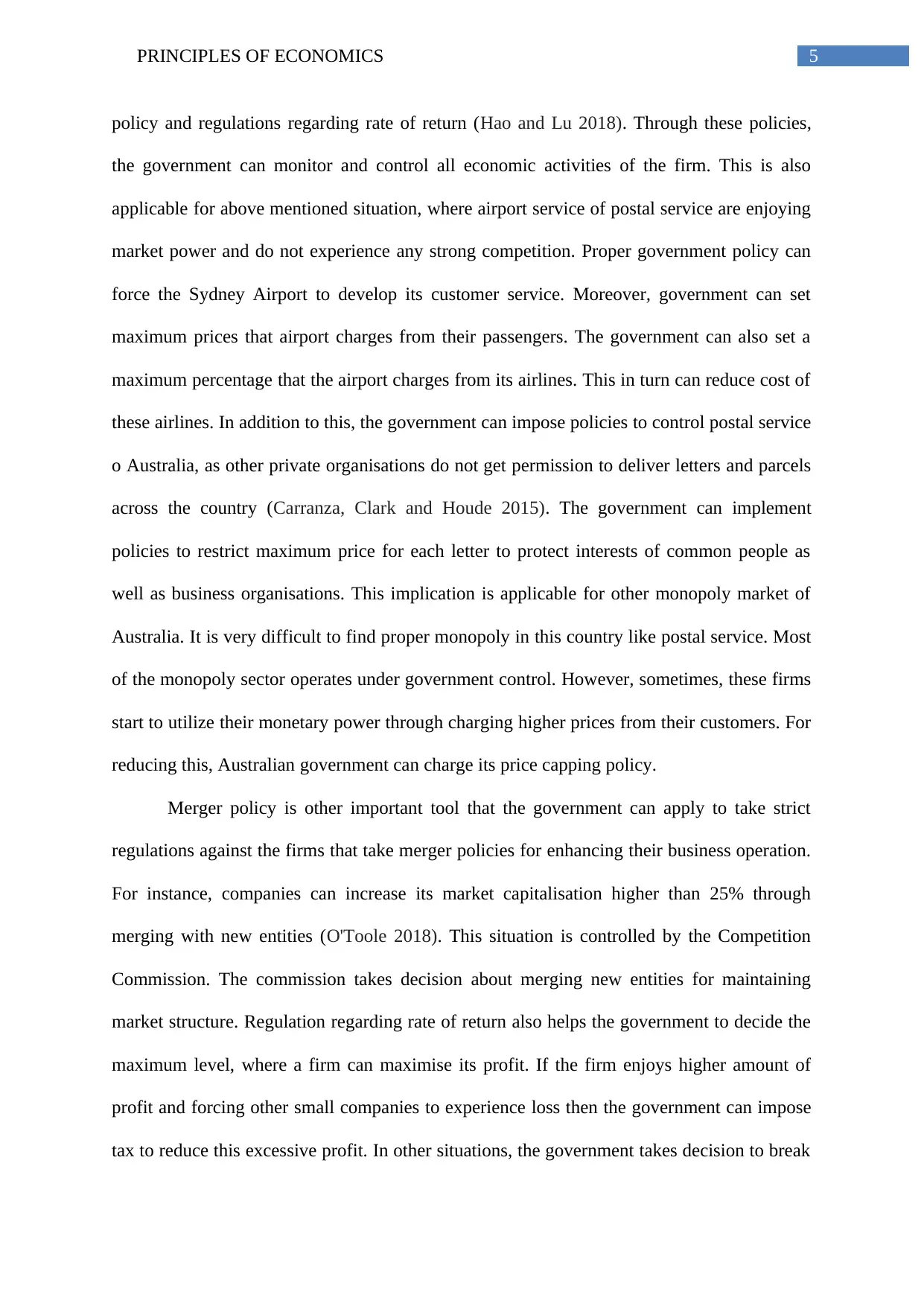
5PRINCIPLES OF ECONOMICS
policy and regulations regarding rate of return (Hao and Lu 2018). Through these policies,
the government can monitor and control all economic activities of the firm. This is also
applicable for above mentioned situation, where airport service of postal service are enjoying
market power and do not experience any strong competition. Proper government policy can
force the Sydney Airport to develop its customer service. Moreover, government can set
maximum prices that airport charges from their passengers. The government can also set a
maximum percentage that the airport charges from its airlines. This in turn can reduce cost of
these airlines. In addition to this, the government can impose policies to control postal service
o Australia, as other private organisations do not get permission to deliver letters and parcels
across the country (Carranza, Clark and Houde 2015). The government can implement
policies to restrict maximum price for each letter to protect interests of common people as
well as business organisations. This implication is applicable for other monopoly market of
Australia. It is very difficult to find proper monopoly in this country like postal service. Most
of the monopoly sector operates under government control. However, sometimes, these firms
start to utilize their monetary power through charging higher prices from their customers. For
reducing this, Australian government can charge its price capping policy.
Merger policy is other important tool that the government can apply to take strict
regulations against the firms that take merger policies for enhancing their business operation.
For instance, companies can increase its market capitalisation higher than 25% through
merging with new entities (O'Toole 2018). This situation is controlled by the Competition
Commission. The commission takes decision about merging new entities for maintaining
market structure. Regulation regarding rate of return also helps the government to decide the
maximum level, where a firm can maximise its profit. If the firm enjoys higher amount of
profit and forcing other small companies to experience loss then the government can impose
tax to reduce this excessive profit. In other situations, the government takes decision to break
policy and regulations regarding rate of return (Hao and Lu 2018). Through these policies,
the government can monitor and control all economic activities of the firm. This is also
applicable for above mentioned situation, where airport service of postal service are enjoying
market power and do not experience any strong competition. Proper government policy can
force the Sydney Airport to develop its customer service. Moreover, government can set
maximum prices that airport charges from their passengers. The government can also set a
maximum percentage that the airport charges from its airlines. This in turn can reduce cost of
these airlines. In addition to this, the government can impose policies to control postal service
o Australia, as other private organisations do not get permission to deliver letters and parcels
across the country (Carranza, Clark and Houde 2015). The government can implement
policies to restrict maximum price for each letter to protect interests of common people as
well as business organisations. This implication is applicable for other monopoly market of
Australia. It is very difficult to find proper monopoly in this country like postal service. Most
of the monopoly sector operates under government control. However, sometimes, these firms
start to utilize their monetary power through charging higher prices from their customers. For
reducing this, Australian government can charge its price capping policy.
Merger policy is other important tool that the government can apply to take strict
regulations against the firms that take merger policies for enhancing their business operation.
For instance, companies can increase its market capitalisation higher than 25% through
merging with new entities (O'Toole 2018). This situation is controlled by the Competition
Commission. The commission takes decision about merging new entities for maintaining
market structure. Regulation regarding rate of return also helps the government to decide the
maximum level, where a firm can maximise its profit. If the firm enjoys higher amount of
profit and forcing other small companies to experience loss then the government can impose
tax to reduce this excessive profit. In other situations, the government takes decision to break
⊘ This is a preview!⊘
Do you want full access?
Subscribe today to unlock all pages.

Trusted by 1+ million students worldwide
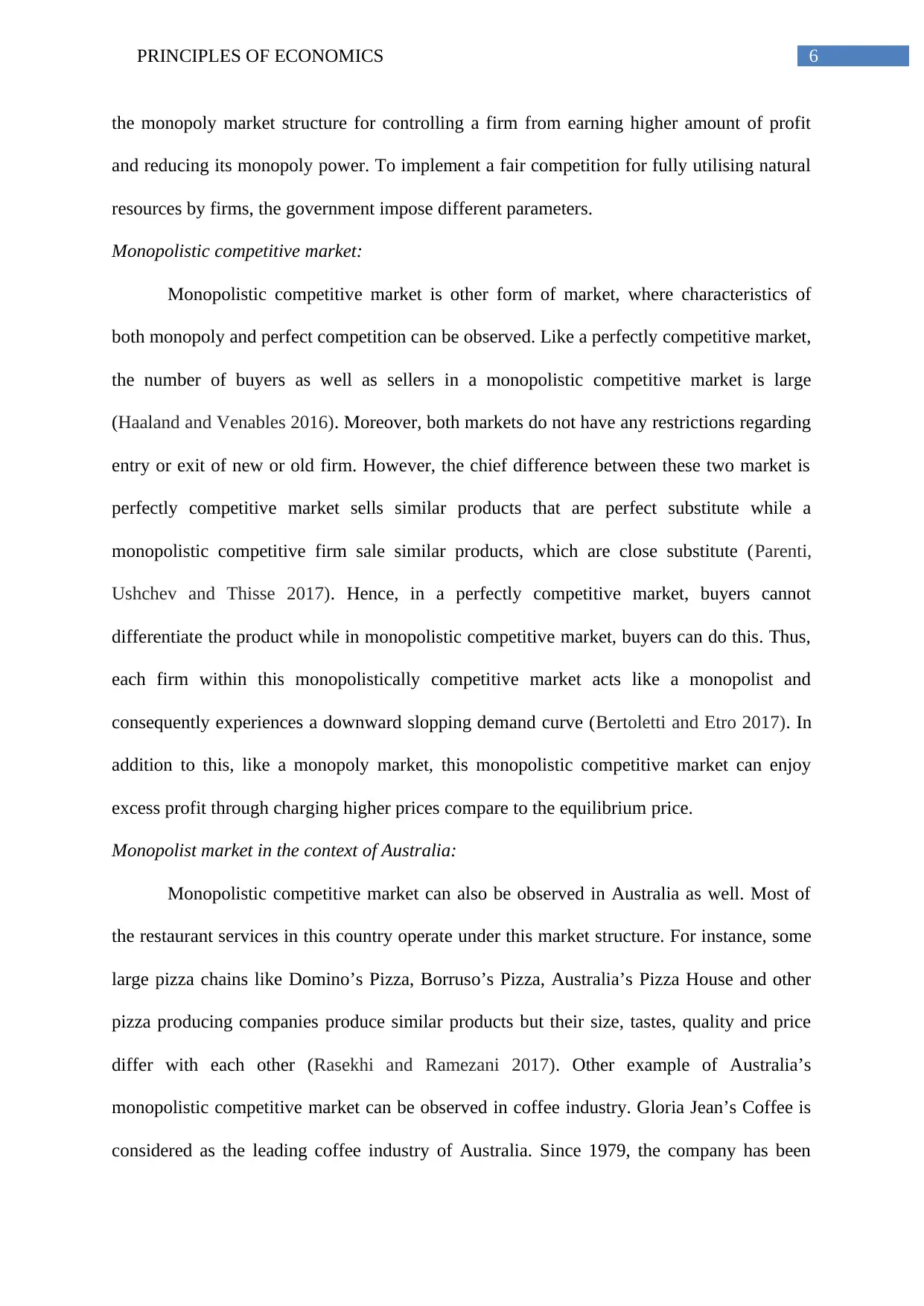
6PRINCIPLES OF ECONOMICS
the monopoly market structure for controlling a firm from earning higher amount of profit
and reducing its monopoly power. To implement a fair competition for fully utilising natural
resources by firms, the government impose different parameters.
Monopolistic competitive market:
Monopolistic competitive market is other form of market, where characteristics of
both monopoly and perfect competition can be observed. Like a perfectly competitive market,
the number of buyers as well as sellers in a monopolistic competitive market is large
(Haaland and Venables 2016). Moreover, both markets do not have any restrictions regarding
entry or exit of new or old firm. However, the chief difference between these two market is
perfectly competitive market sells similar products that are perfect substitute while a
monopolistic competitive firm sale similar products, which are close substitute (Parenti,
Ushchev and Thisse 2017). Hence, in a perfectly competitive market, buyers cannot
differentiate the product while in monopolistic competitive market, buyers can do this. Thus,
each firm within this monopolistically competitive market acts like a monopolist and
consequently experiences a downward slopping demand curve (Bertoletti and Etro 2017). In
addition to this, like a monopoly market, this monopolistic competitive market can enjoy
excess profit through charging higher prices compare to the equilibrium price.
Monopolist market in the context of Australia:
Monopolistic competitive market can also be observed in Australia as well. Most of
the restaurant services in this country operate under this market structure. For instance, some
large pizza chains like Domino’s Pizza, Borruso’s Pizza, Australia’s Pizza House and other
pizza producing companies produce similar products but their size, tastes, quality and price
differ with each other (Rasekhi and Ramezani 2017). Other example of Australia’s
monopolistic competitive market can be observed in coffee industry. Gloria Jean’s Coffee is
considered as the leading coffee industry of Australia. Since 1979, the company has been
the monopoly market structure for controlling a firm from earning higher amount of profit
and reducing its monopoly power. To implement a fair competition for fully utilising natural
resources by firms, the government impose different parameters.
Monopolistic competitive market:
Monopolistic competitive market is other form of market, where characteristics of
both monopoly and perfect competition can be observed. Like a perfectly competitive market,
the number of buyers as well as sellers in a monopolistic competitive market is large
(Haaland and Venables 2016). Moreover, both markets do not have any restrictions regarding
entry or exit of new or old firm. However, the chief difference between these two market is
perfectly competitive market sells similar products that are perfect substitute while a
monopolistic competitive firm sale similar products, which are close substitute (Parenti,
Ushchev and Thisse 2017). Hence, in a perfectly competitive market, buyers cannot
differentiate the product while in monopolistic competitive market, buyers can do this. Thus,
each firm within this monopolistically competitive market acts like a monopolist and
consequently experiences a downward slopping demand curve (Bertoletti and Etro 2017). In
addition to this, like a monopoly market, this monopolistic competitive market can enjoy
excess profit through charging higher prices compare to the equilibrium price.
Monopolist market in the context of Australia:
Monopolistic competitive market can also be observed in Australia as well. Most of
the restaurant services in this country operate under this market structure. For instance, some
large pizza chains like Domino’s Pizza, Borruso’s Pizza, Australia’s Pizza House and other
pizza producing companies produce similar products but their size, tastes, quality and price
differ with each other (Rasekhi and Ramezani 2017). Other example of Australia’s
monopolistic competitive market can be observed in coffee industry. Gloria Jean’s Coffee is
considered as the leading coffee industry of Australia. Since 1979, the company has been
Paraphrase This Document
Need a fresh take? Get an instant paraphrase of this document with our AI Paraphraser
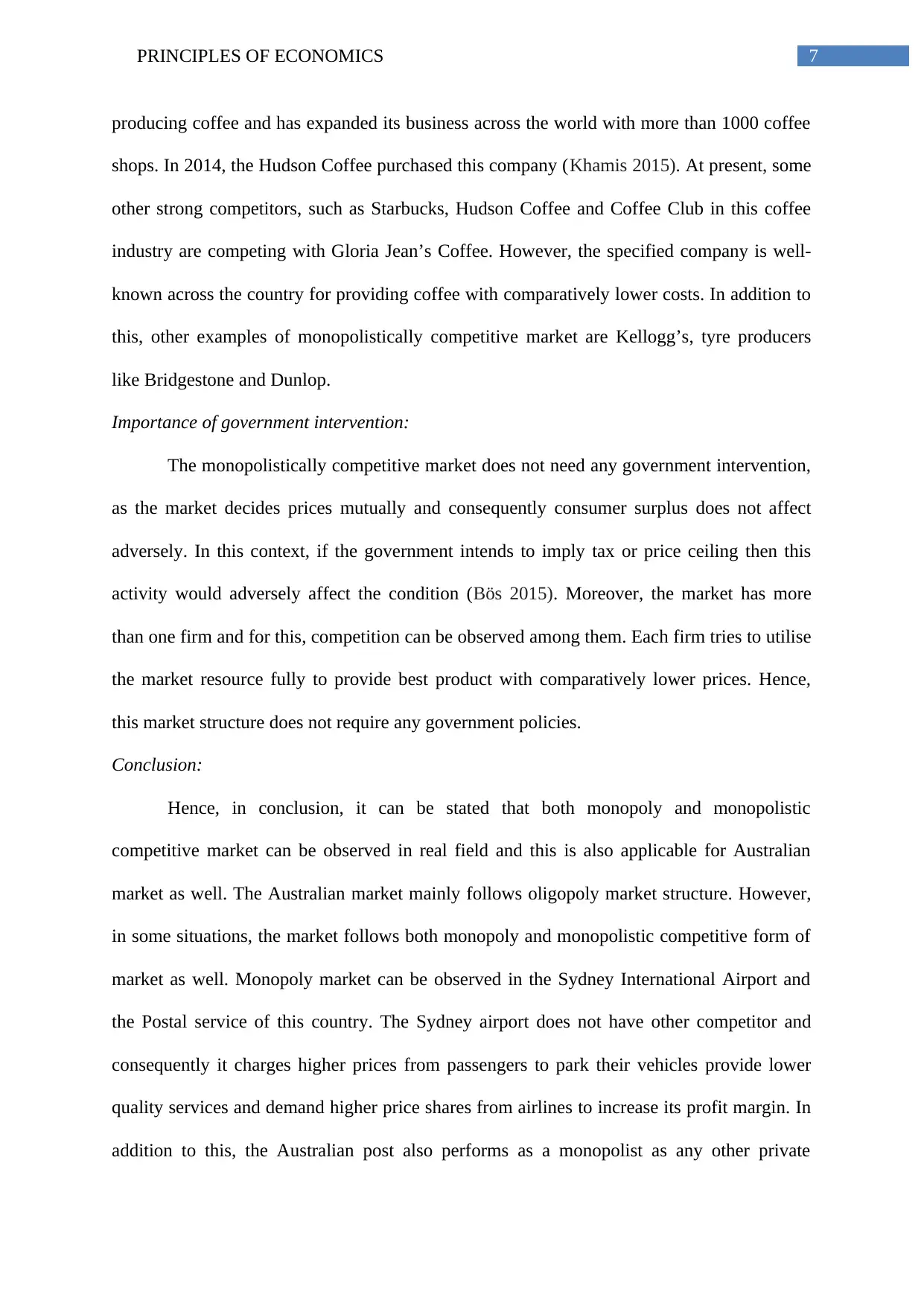
7PRINCIPLES OF ECONOMICS
producing coffee and has expanded its business across the world with more than 1000 coffee
shops. In 2014, the Hudson Coffee purchased this company (Khamis 2015). At present, some
other strong competitors, such as Starbucks, Hudson Coffee and Coffee Club in this coffee
industry are competing with Gloria Jean’s Coffee. However, the specified company is well-
known across the country for providing coffee with comparatively lower costs. In addition to
this, other examples of monopolistically competitive market are Kellogg’s, tyre producers
like Bridgestone and Dunlop.
Importance of government intervention:
The monopolistically competitive market does not need any government intervention,
as the market decides prices mutually and consequently consumer surplus does not affect
adversely. In this context, if the government intends to imply tax or price ceiling then this
activity would adversely affect the condition (Bös 2015). Moreover, the market has more
than one firm and for this, competition can be observed among them. Each firm tries to utilise
the market resource fully to provide best product with comparatively lower prices. Hence,
this market structure does not require any government policies.
Conclusion:
Hence, in conclusion, it can be stated that both monopoly and monopolistic
competitive market can be observed in real field and this is also applicable for Australian
market as well. The Australian market mainly follows oligopoly market structure. However,
in some situations, the market follows both monopoly and monopolistic competitive form of
market as well. Monopoly market can be observed in the Sydney International Airport and
the Postal service of this country. The Sydney airport does not have other competitor and
consequently it charges higher prices from passengers to park their vehicles provide lower
quality services and demand higher price shares from airlines to increase its profit margin. In
addition to this, the Australian post also performs as a monopolist as any other private
producing coffee and has expanded its business across the world with more than 1000 coffee
shops. In 2014, the Hudson Coffee purchased this company (Khamis 2015). At present, some
other strong competitors, such as Starbucks, Hudson Coffee and Coffee Club in this coffee
industry are competing with Gloria Jean’s Coffee. However, the specified company is well-
known across the country for providing coffee with comparatively lower costs. In addition to
this, other examples of monopolistically competitive market are Kellogg’s, tyre producers
like Bridgestone and Dunlop.
Importance of government intervention:
The monopolistically competitive market does not need any government intervention,
as the market decides prices mutually and consequently consumer surplus does not affect
adversely. In this context, if the government intends to imply tax or price ceiling then this
activity would adversely affect the condition (Bös 2015). Moreover, the market has more
than one firm and for this, competition can be observed among them. Each firm tries to utilise
the market resource fully to provide best product with comparatively lower prices. Hence,
this market structure does not require any government policies.
Conclusion:
Hence, in conclusion, it can be stated that both monopoly and monopolistic
competitive market can be observed in real field and this is also applicable for Australian
market as well. The Australian market mainly follows oligopoly market structure. However,
in some situations, the market follows both monopoly and monopolistic competitive form of
market as well. Monopoly market can be observed in the Sydney International Airport and
the Postal service of this country. The Sydney airport does not have other competitor and
consequently it charges higher prices from passengers to park their vehicles provide lower
quality services and demand higher price shares from airlines to increase its profit margin. In
addition to this, the Australian post also performs as a monopolist as any other private
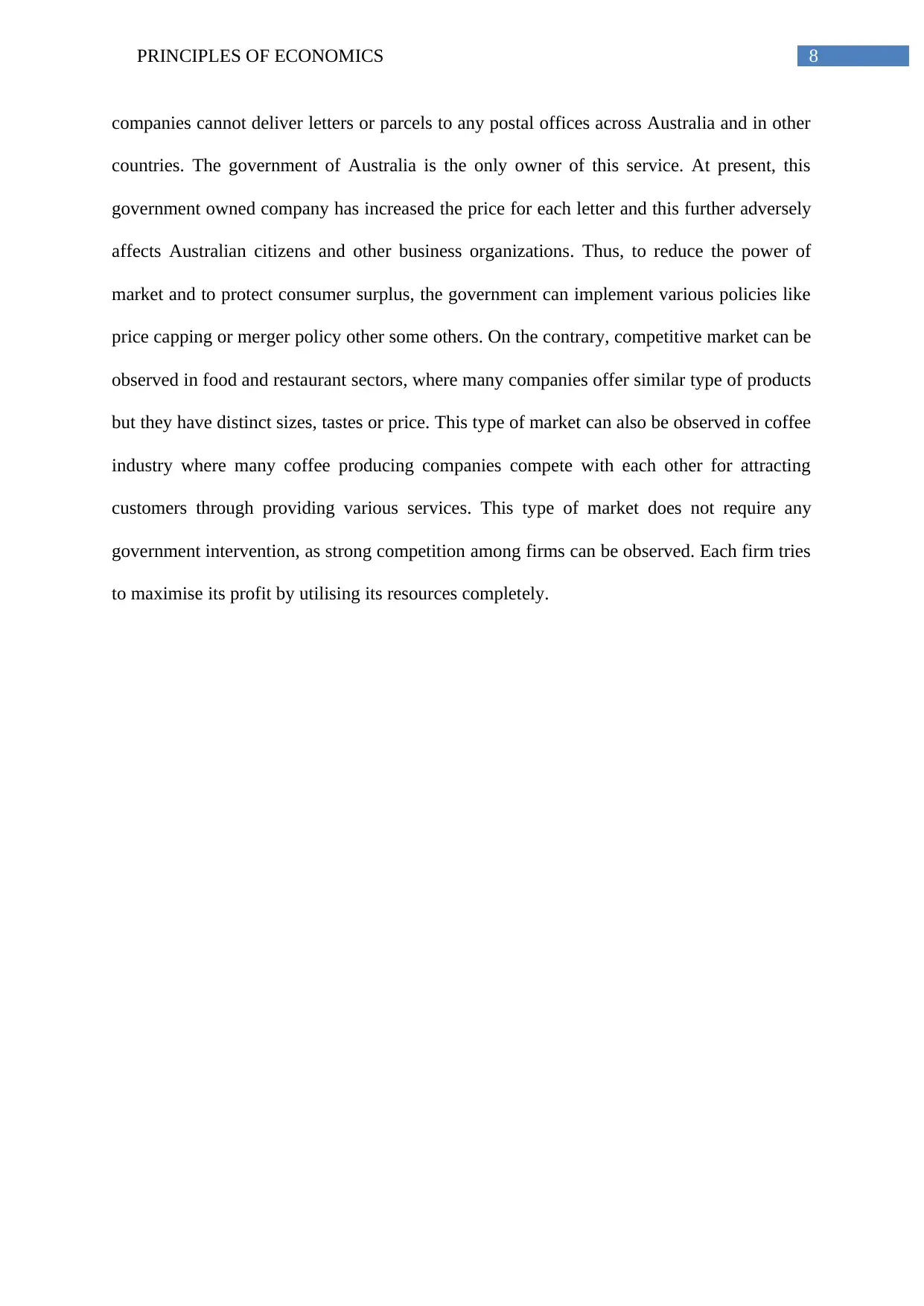
8PRINCIPLES OF ECONOMICS
companies cannot deliver letters or parcels to any postal offices across Australia and in other
countries. The government of Australia is the only owner of this service. At present, this
government owned company has increased the price for each letter and this further adversely
affects Australian citizens and other business organizations. Thus, to reduce the power of
market and to protect consumer surplus, the government can implement various policies like
price capping or merger policy other some others. On the contrary, competitive market can be
observed in food and restaurant sectors, where many companies offer similar type of products
but they have distinct sizes, tastes or price. This type of market can also be observed in coffee
industry where many coffee producing companies compete with each other for attracting
customers through providing various services. This type of market does not require any
government intervention, as strong competition among firms can be observed. Each firm tries
to maximise its profit by utilising its resources completely.
companies cannot deliver letters or parcels to any postal offices across Australia and in other
countries. The government of Australia is the only owner of this service. At present, this
government owned company has increased the price for each letter and this further adversely
affects Australian citizens and other business organizations. Thus, to reduce the power of
market and to protect consumer surplus, the government can implement various policies like
price capping or merger policy other some others. On the contrary, competitive market can be
observed in food and restaurant sectors, where many companies offer similar type of products
but they have distinct sizes, tastes or price. This type of market can also be observed in coffee
industry where many coffee producing companies compete with each other for attracting
customers through providing various services. This type of market does not require any
government intervention, as strong competition among firms can be observed. Each firm tries
to maximise its profit by utilising its resources completely.
⊘ This is a preview!⊘
Do you want full access?
Subscribe today to unlock all pages.

Trusted by 1+ million students worldwide
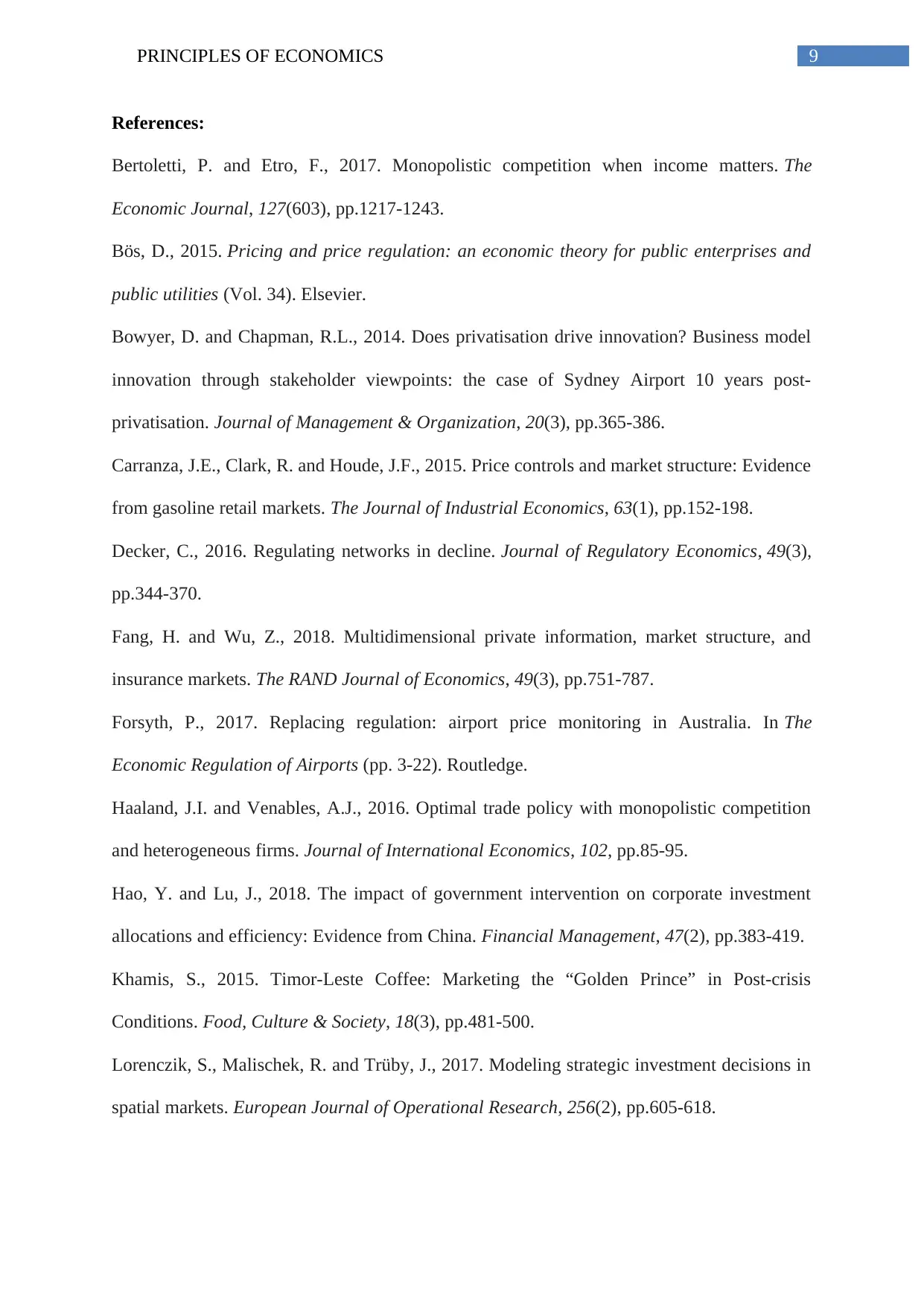
9PRINCIPLES OF ECONOMICS
References:
Bertoletti, P. and Etro, F., 2017. Monopolistic competition when income matters. The
Economic Journal, 127(603), pp.1217-1243.
Bös, D., 2015. Pricing and price regulation: an economic theory for public enterprises and
public utilities (Vol. 34). Elsevier.
Bowyer, D. and Chapman, R.L., 2014. Does privatisation drive innovation? Business model
innovation through stakeholder viewpoints: the case of Sydney Airport 10 years post-
privatisation. Journal of Management & Organization, 20(3), pp.365-386.
Carranza, J.E., Clark, R. and Houde, J.F., 2015. Price controls and market structure: Evidence
from gasoline retail markets. The Journal of Industrial Economics, 63(1), pp.152-198.
Decker, C., 2016. Regulating networks in decline. Journal of Regulatory Economics, 49(3),
pp.344-370.
Fang, H. and Wu, Z., 2018. Multidimensional private information, market structure, and
insurance markets. The RAND Journal of Economics, 49(3), pp.751-787.
Forsyth, P., 2017. Replacing regulation: airport price monitoring in Australia. In The
Economic Regulation of Airports (pp. 3-22). Routledge.
Haaland, J.I. and Venables, A.J., 2016. Optimal trade policy with monopolistic competition
and heterogeneous firms. Journal of International Economics, 102, pp.85-95.
Hao, Y. and Lu, J., 2018. The impact of government intervention on corporate investment
allocations and efficiency: Evidence from China. Financial Management, 47(2), pp.383-419.
Khamis, S., 2015. Timor-Leste Coffee: Marketing the “Golden Prince” in Post-crisis
Conditions. Food, Culture & Society, 18(3), pp.481-500.
Lorenczik, S., Malischek, R. and Trüby, J., 2017. Modeling strategic investment decisions in
spatial markets. European Journal of Operational Research, 256(2), pp.605-618.
References:
Bertoletti, P. and Etro, F., 2017. Monopolistic competition when income matters. The
Economic Journal, 127(603), pp.1217-1243.
Bös, D., 2015. Pricing and price regulation: an economic theory for public enterprises and
public utilities (Vol. 34). Elsevier.
Bowyer, D. and Chapman, R.L., 2014. Does privatisation drive innovation? Business model
innovation through stakeholder viewpoints: the case of Sydney Airport 10 years post-
privatisation. Journal of Management & Organization, 20(3), pp.365-386.
Carranza, J.E., Clark, R. and Houde, J.F., 2015. Price controls and market structure: Evidence
from gasoline retail markets. The Journal of Industrial Economics, 63(1), pp.152-198.
Decker, C., 2016. Regulating networks in decline. Journal of Regulatory Economics, 49(3),
pp.344-370.
Fang, H. and Wu, Z., 2018. Multidimensional private information, market structure, and
insurance markets. The RAND Journal of Economics, 49(3), pp.751-787.
Forsyth, P., 2017. Replacing regulation: airport price monitoring in Australia. In The
Economic Regulation of Airports (pp. 3-22). Routledge.
Haaland, J.I. and Venables, A.J., 2016. Optimal trade policy with monopolistic competition
and heterogeneous firms. Journal of International Economics, 102, pp.85-95.
Hao, Y. and Lu, J., 2018. The impact of government intervention on corporate investment
allocations and efficiency: Evidence from China. Financial Management, 47(2), pp.383-419.
Khamis, S., 2015. Timor-Leste Coffee: Marketing the “Golden Prince” in Post-crisis
Conditions. Food, Culture & Society, 18(3), pp.481-500.
Lorenczik, S., Malischek, R. and Trüby, J., 2017. Modeling strategic investment decisions in
spatial markets. European Journal of Operational Research, 256(2), pp.605-618.
Paraphrase This Document
Need a fresh take? Get an instant paraphrase of this document with our AI Paraphraser
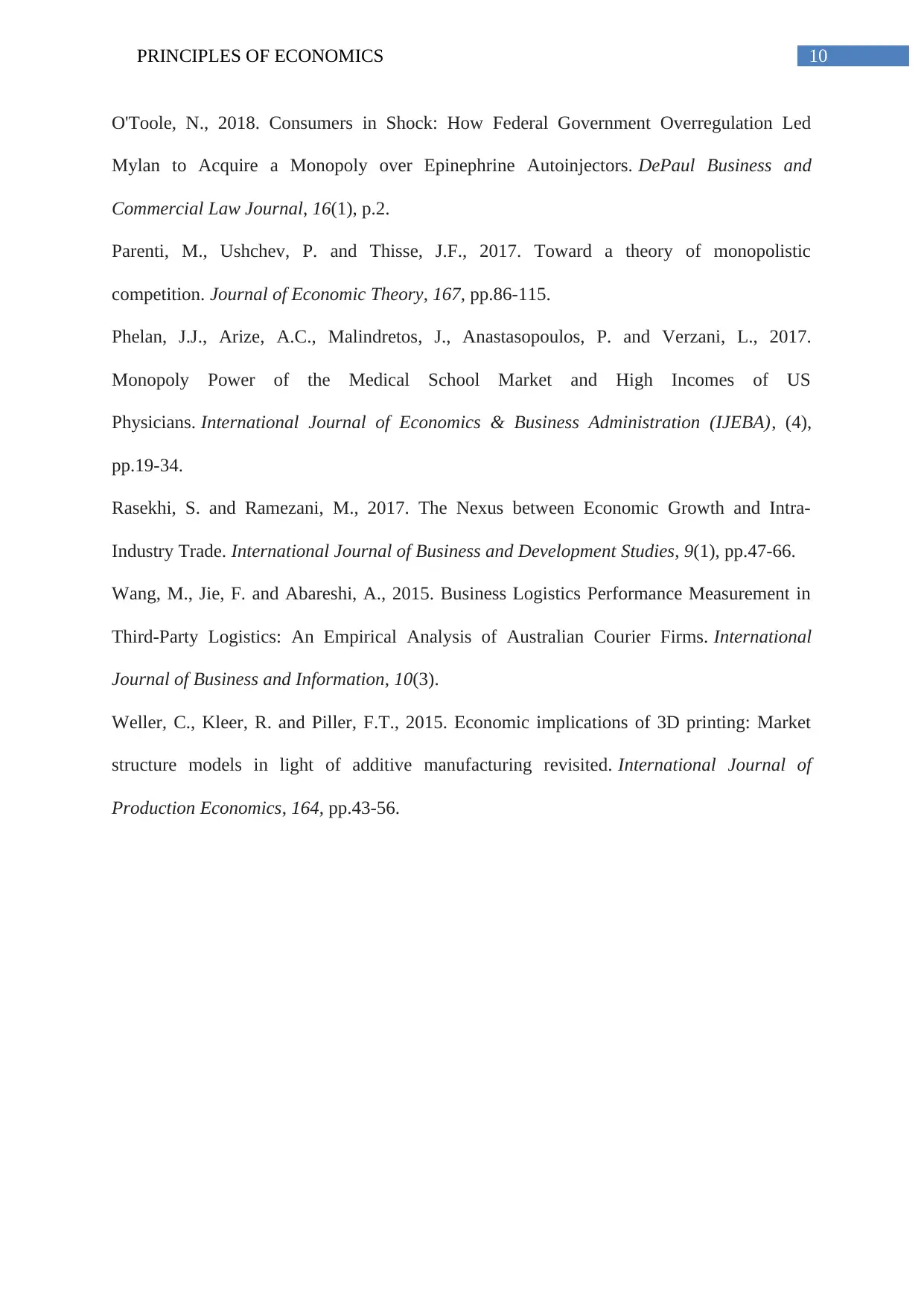
10PRINCIPLES OF ECONOMICS
O'Toole, N., 2018. Consumers in Shock: How Federal Government Overregulation Led
Mylan to Acquire a Monopoly over Epinephrine Autoinjectors. DePaul Business and
Commercial Law Journal, 16(1), p.2.
Parenti, M., Ushchev, P. and Thisse, J.F., 2017. Toward a theory of monopolistic
competition. Journal of Economic Theory, 167, pp.86-115.
Phelan, J.J., Arize, A.C., Malindretos, J., Anastasopoulos, P. and Verzani, L., 2017.
Monopoly Power of the Medical School Market and High Incomes of US
Physicians. International Journal of Economics & Business Administration (IJEBA), (4),
pp.19-34.
Rasekhi, S. and Ramezani, M., 2017. The Nexus between Economic Growth and Intra-
Industry Trade. International Journal of Business and Development Studies, 9(1), pp.47-66.
Wang, M., Jie, F. and Abareshi, A., 2015. Business Logistics Performance Measurement in
Third-Party Logistics: An Empirical Analysis of Australian Courier Firms. International
Journal of Business and Information, 10(3).
Weller, C., Kleer, R. and Piller, F.T., 2015. Economic implications of 3D printing: Market
structure models in light of additive manufacturing revisited. International Journal of
Production Economics, 164, pp.43-56.
O'Toole, N., 2018. Consumers in Shock: How Federal Government Overregulation Led
Mylan to Acquire a Monopoly over Epinephrine Autoinjectors. DePaul Business and
Commercial Law Journal, 16(1), p.2.
Parenti, M., Ushchev, P. and Thisse, J.F., 2017. Toward a theory of monopolistic
competition. Journal of Economic Theory, 167, pp.86-115.
Phelan, J.J., Arize, A.C., Malindretos, J., Anastasopoulos, P. and Verzani, L., 2017.
Monopoly Power of the Medical School Market and High Incomes of US
Physicians. International Journal of Economics & Business Administration (IJEBA), (4),
pp.19-34.
Rasekhi, S. and Ramezani, M., 2017. The Nexus between Economic Growth and Intra-
Industry Trade. International Journal of Business and Development Studies, 9(1), pp.47-66.
Wang, M., Jie, F. and Abareshi, A., 2015. Business Logistics Performance Measurement in
Third-Party Logistics: An Empirical Analysis of Australian Courier Firms. International
Journal of Business and Information, 10(3).
Weller, C., Kleer, R. and Piller, F.T., 2015. Economic implications of 3D printing: Market
structure models in light of additive manufacturing revisited. International Journal of
Production Economics, 164, pp.43-56.
1 out of 11
Related Documents
Your All-in-One AI-Powered Toolkit for Academic Success.
+13062052269
info@desklib.com
Available 24*7 on WhatsApp / Email
![[object Object]](/_next/static/media/star-bottom.7253800d.svg)
Unlock your academic potential
Copyright © 2020–2025 A2Z Services. All Rights Reserved. Developed and managed by ZUCOL.





